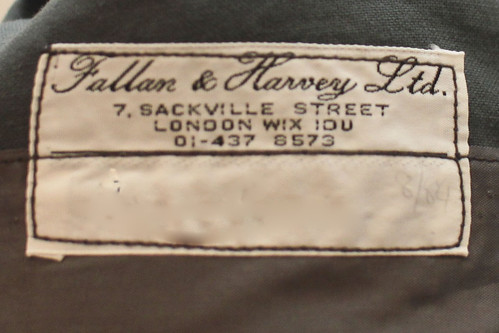
I am beginning to wonder if the 1980's were just dark years for West-End tailors.
The latest dissection candidate, (donated by mack11211, thank you) is a piece by London's Fallan and Harvey, dating to 1984 and it is, at best, underwhelming, coming from one of a group of tailors who are supposed to be the finest in the world. Let's assume, however, that the garment fit and the customer was pleased and that the nit-picking we are about to do would never have bothered him. (On the other hand, when you are being charged for the best, one can reasonably assume that one will receive the best.)
The finishing is sloppy and rather amateurish, but to their credit, the lining has been inserted by hand which is a step that few houses do anymore.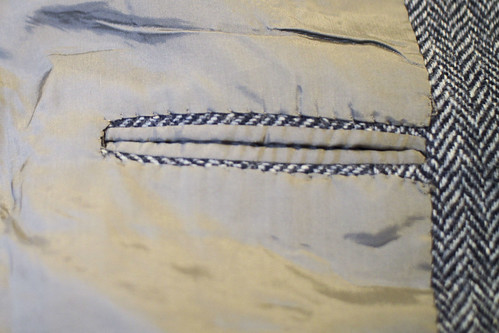
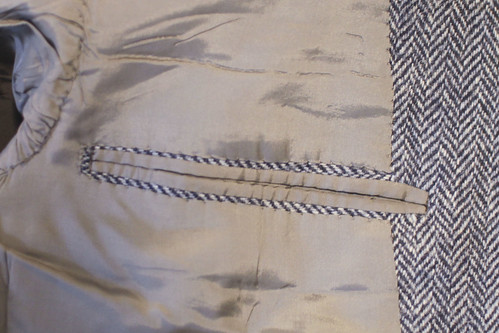
The buttonholes aren't much better.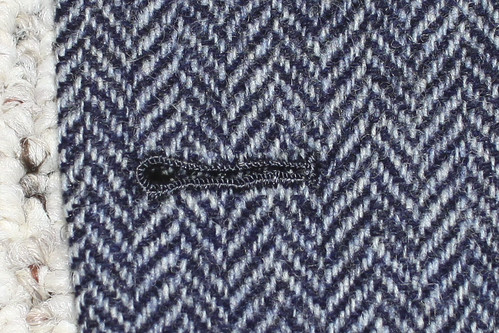
It is interesting to note that the vent has been fused which will be a sign of either forward-thinking or corner-cutting, depending on which side of the traditionalism fence you sit. Personally, on this weight of tweed, I don't think a bit of fusible will hurt the garment, other than if it were to eventually fail.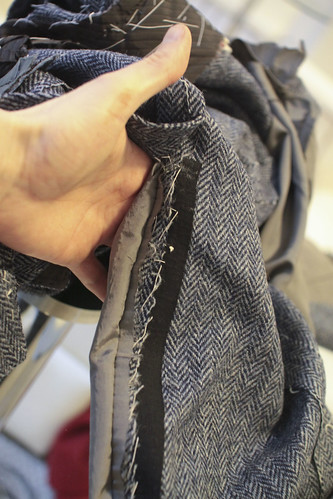
The edge tape is also fusible, but as on the Welsh and Jeffries garment we looked at, it has also been sewn on by hand. So I am leaning toward "forward-thinking".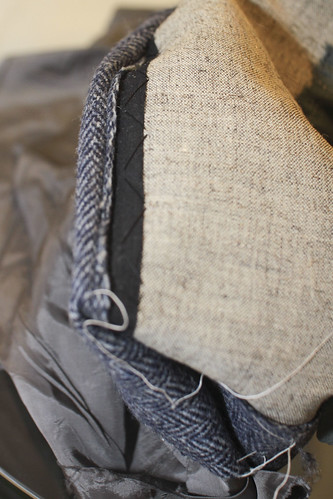
Interestingly, the lapel has three different types of tape. The bridle has been stayed with linen holland, the top edge has been stayed with fusible, and the lapel edge has a non-woven which may at one point have been fusible but if it was, the resin has failed. In any case, it was sewn on by hand so it doesn't matter.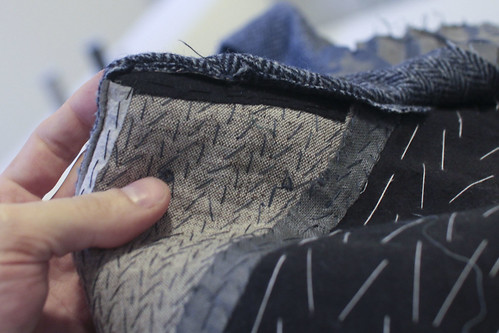
The undercollar has been machined. This is another instance where I don't think hand-padding adds anything of value but traditionalists will squawk.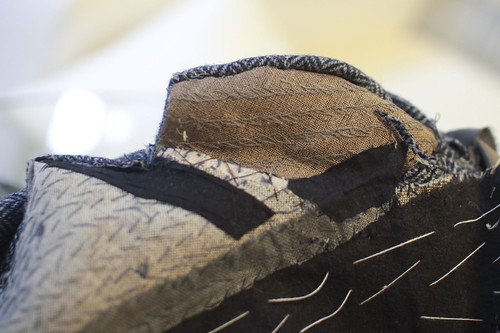
The back of the scye has been padded, likely to help with some very prominent blades.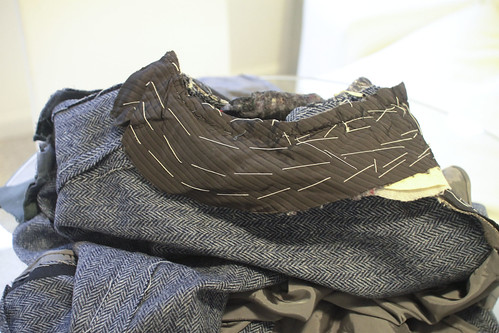
Under the padding we find a linen holland stay tape which shows that the sleeves have been set by machine. Though they see no value in hand-setting the sleeves, the shoulder seam has been sewn by hand.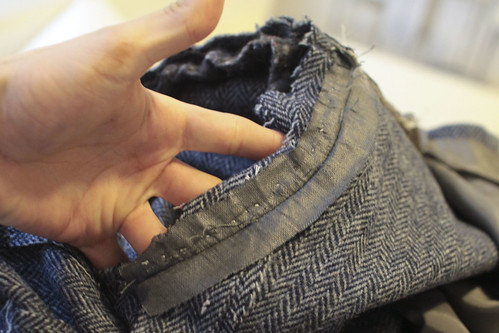
The chest has been made with one large piece of haircloth and one bias-cut piece of wrapped hair.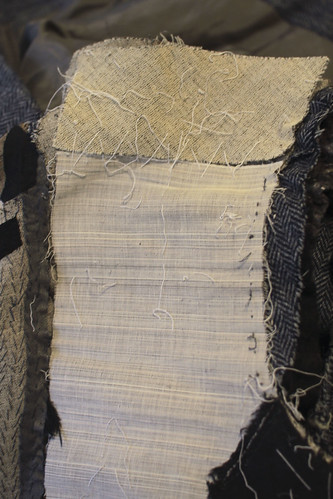
Malwae was asking about canvas qualities and here is an example of a bad quality haircloth. The weave is such that the hair slips right through- I was able to easily pull a strand right through-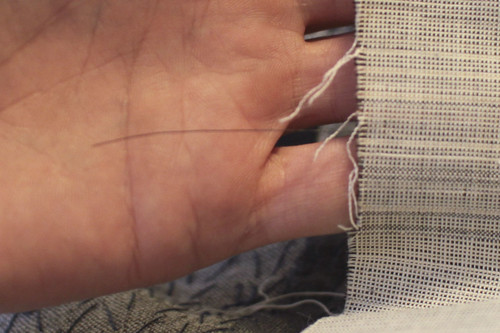
This kind of thing is trouble for migration as the hair will start poking right through and bother the wearer. When selecting haircloth you want to pinch the edge and give it a good tug. If the weave grins, as it has in the photo below, avoid it. The hair should be crimped so that the weave is stable and the hair won't move.
This is not the first garment from that time period which was a little dodgy-looking; maybe in the boom that was the 1980s, Savile Row had to pump garments out at such high volume that quality slipped for a while. Maybe this was just a fluke. Who knows. In any case, I am hoping that the quality level has improved in the nearly 30 years that have passed since this garment was made and I will keep my eye out for a more recent example that would show it.








18 comments:
thank you for this mr d. just a small question, is stretching the cloth alone not enough with reference to the back of the scye being padded to allow for more prominent shoulder blades?
Thanks for another interesting dissection. It would be indeed interesting to see what a coat made within the last ten or even 5 years looks like.
Thank you for another lesson, Jeffery! Keep 'em coming!
You mentioned the buttonholes not being so good. Can you put up a picture, please?
@s. - Stretching the blades and shrinking the scye is usually enough to fit even the toughest blades. The cutter may have wanted to smooth out the appearance by padding the scye. Or maybe it was for another reason.
@GG- indeed.
@Kim- you're welcome, and I will.
@Anonymous- done.
My goodness; you weren't kidding. The hole at the end of the keyhole is okay, but the straight part leading up to it is crooked and the stitch density is inconsistent. On newer examples that I've seen (1998), the buttonholes are much better, but not better than, say, the ones on that Caraceni. Those were easily some of the best I've seen.
Thanks for the picture and looking forward to the next suit!
From the wobbly look of that buttonhole, m'thinks the tailor was tippling during his lunch break or
still had a hangover from last night's binge. I suppose it's possible he may have neglected to insert Agreman gimp under the silk buttonhole twist to maintain the alignment. Pity he never saw the exquisite handiwork of your buttonholes.
JMB
Hi Jeff,
I'm of the opinion that a bit of fusing on raw edges does help in that from my experience, heavy tweeds fray rather easily on the edges. So I suppose there is logic to the fusing seen here. What do you think?
@Anonymous- you want buttonholes? Wait until you see the next suit...
@BENEDICT17- Thank you. And they did, in fact, use the gimp.
@brendan- the fusing is not intended to prevent fraying in this case as it doesn't go right to the edge. There could be a number of possible reasons to do it but I can't think of any really good ones. You wouldn't even find this kind of edge tape on a factory-made canvas garment. The gorge, yes, as it prevents stretching in that area.
I hate to say this but the craftsmanship looks a lot like the work I did as a student. Not really lacking in the basic sewing skills to make the garment but the patients to do it properly.
"Wait until you see the next suit..."
You're such a tease Jeffery :P
I look forward to your next buttonholes Jeffrey. Der Zuschneider always says you simply have "golden hands".
Ooooohhh, is the next one the Smalto? I've seen the Milanese/upside-down/satin buttonholes on their lapels from time to time. BTW, did you ever figure out how to make them?
@GG- no, not my buttonholes. Somebody else's.
@J.Mac- A tease? Really? :)
@Anonymous- no, I'm going to sit on the Smalto for a bit because I may have a much older one coming and it will be interesting to compare them. And I haven't figured out those buttonholes yet.
We can also add to the growing list a Gieves & Hawkes bespoke suit (thank you Simon) and a Kiton jacket. Then I have to stop spending money and get back to work on making myself some clothing!
@Anonymous-
Well, I figured them out. The upside-down Milanese buttonhole things- it came to me in the car on the way home last night. I'm pretty sure you need a finer silk thread though- I've asked a friend who knows people inside the Zegna factory where they make Tom Ford suits so hopefully I'll have some answers soon. And once I've practiced them a bit I'll post the technique.
RE: Milanese buttonholes- That would be brilliant, I'll prolly never ever use them, but it would be nice to know how to do them.
Great!! I can't wait for the post!
I've seen them mostly on formalwear: a few Brioni DJs and an ancient morning coat, but also on an Ungaro suit and a Battistoni (also that Tom Ford). I think it works best on silk satin. It looks okay on grosgrain, but the ribbed texture is better complimented by the purls of a regular buttonhole. I think on select wools it can look good, but it works much better on silk,
These pictures made your previous discussion of the quality of canvas much clearer - thank you! I can now recall seeing this more loosely woven canvasing inside suits I took apart (from thrift stores) and I thought it was a different type of thing all together, not just a gimpy version of the good stuff.
Post a Comment